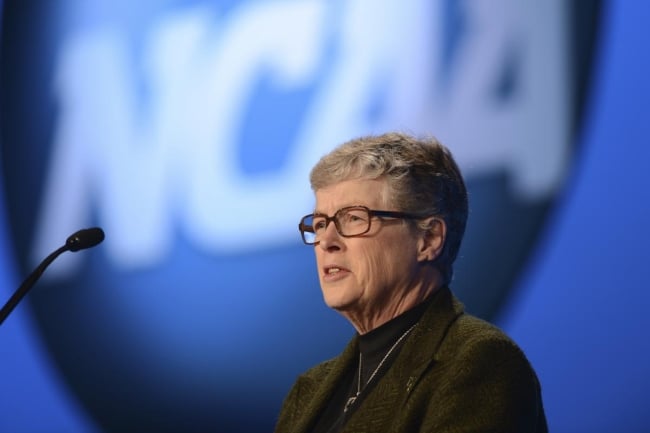You have /5 articles left.
Sign up for a free account or log in.

Lou Anna K. Simon, pictured here at a past NCAA event when she was president of Michigan State, was recently honored by her former employer despite leaving amid a major scandal.
NCAA Photos/Contributor/Getty Images
Lou Anna K. Simon and Graham Spanier are arguably among the most controversial U.S. college presidents to have served in recent years. Both left their institutions—Michigan State University and Pennsylvania State University, respectively—under a cloud cast by predatory sex-abuse scandals that took place on their watch.
But despite their tarnished reputations, neither is a stranger to the campus they unceremoniously departed. And their persona non grata status among many campus constituents hasn’t stopped their prior employers from honoring them. Among other things, both carry president emeritus status at their respective institutions.
Simon—who narrowly avoided criminal charges for allegedly lying to investigators about what she knew regarding the Larry Nassar sexual abuse scandal—recently received a presidential portrait at Michigan State that was unveiled in a private ceremony. The portrait, if not the ceremony, was part of her exit agreement, which also listed a litany of other perks, including lifetime benefits for Simon and her husband ranging from health care to technical support, according to a copy of the exit agreement provided by Michigan State.
Simon’s portrait now hangs in the campus boardroom where MSU trustees meet. (A Michigan State spokesperson notes this is “consistent with the display of past presidents’ portraits.”)
Spanier, who spent nearly two months in jail for endangering the welfare of children—a conviction related to his role as president during the Jerry Sandusky sexual abuse scandal at Penn State—didn’t get the presidential portrait treatment but continued to draw a salary as a tenured professor, without teaching responsibilities, after stepping down. He told Inside Higher Ed, by email, he is “unaware of any perks” and declined to discuss payments he received as a faculty member.
Penn State, for its part, is unwilling to share any details of Spanier’s exit agreement. And while Penn State hasn’t honored him to the extent that Michigan State has honored Simon, Spanier was scheduled to return to campus last week for a presentation about his recent book recapping the events of the Sandusky scandal, which downplays his role and responsibilities. That talk was canceled due to winter weather and has not yet been rescheduled.
When Disgraced Presidents Return
While Simon and Spanier may be among the more notorious presidents to resign amid scandal, they’re not alone in the club of ousted presidents who can still count on big payouts and honorifics from their former employers.
Spanier stepped down at Penn State more than a decade ago. Simon followed suit in 2018. But the shadows of their actions—and inactions—still linger on both campuses.
While Michigan State has remained largely quiet on the secret ceremony that marked the unveiling of Simon’s presidential portrait—declining to answer most of Inside Higher Ed’s questions—others at Michigan State have expressed outrage and consternation.
Reclaim MSU, a group of students, employees and alumni that emerged during the Nassar scandal, was sharply critical of the decision to honor Simon, tweeting, “An institutional crisis began under Simon’s leadership. It is not over. Administrators must STOP minimizing what has happened at MSU — and what happens still. Instead, we need transparency and transformation.”
But Michigan State has provided little transparency about the Dec. 19 event honoring Simon, which was moved from its initial location to a larger venue. Interim president Teresa Woodruff attended, as did some trustees; others refused to participate.
The ceremony went on despite pressure on campus to cancel the event. Multiple speakers at MSU’s Dec. 16 Board of Trustees meeting raised concerns about honoring Simon.
Shawnee Vickery, a business professor at Michigan State, chastised the board, calling on trustees to nix the reception. She said it was a “smack in the face” to survivors. Vickery told Inside Higher Ed that “in light of what happened, there shouldn’t be any honorifics” for Simon.
Vickery said she first learned about the ceremony at the board meeting, which she attended to speak on another topic: the ouster of Sanjay Gupta as dean of MSU’s Broad School of Business, who resigned amid concerns that he failed to report incidents of sexual misconduct that occurred under his leadership. An investigation into that incident is ongoing. But critics of the board see a failure of transparency on the Gupta situation, which they say is consistent with how MSU typically handles Title IX matters.
Anna Pegler-Gordon, a Michigan State history professor, also spoke at the board meeting, criticizing the lack of communication around the portrait unveiling. “MSU is a public institution, and the public deserves information about it,” she said. She also took issue with the timing of the event—after finals—which she suggested was designed to limit protests.
In an email to Inside Higher Ed, Pegler-Gordon—referencing a discussion she had with the mother of a sexual abuse victim—said, “Title IX is the thread that links together so much of MSU’s institutional betrayal of survivors, students, athletes and faculty.” She cited alleged mismanagement and a lack of communication around the Nassar scandal, the Gupta dismissal and investigation, and the ouster of former president Dr. Samuel Stanley Jr., which was also related to Title IX issues.
Most trustees did not address the concerns raised about the ceremony in their remarks at the December meeting, though board member Brianna Scott said she would not attend the event.
“It was a surprise to me, and I personally do not support it,” Scott said at the meeting.
Board leaders did not respond to a request for comment.
While Simon had her recent moment at Michigan State, Spanier is still waiting for his book talk to be rescheduled. And some campus constituents are concerned about welcoming him back.
 “I think a lot of students are wary of the book signing and uncomfortable with how much publicity this event will draw toward Penn State and toward Graham Spanier himself, especially because our school has really tried to move on from the Sandusky case over the last few years,” Sydney Gibbard, Penn State’s undergraduate student body president, told Inside Higher Ed by email. “That being said, there is definitely a large population of students that don’t know as much about the history of Penn State and probably are not as affected by this happening on campus.”
“I think a lot of students are wary of the book signing and uncomfortable with how much publicity this event will draw toward Penn State and toward Graham Spanier himself, especially because our school has really tried to move on from the Sandusky case over the last few years,” Sydney Gibbard, Penn State’s undergraduate student body president, told Inside Higher Ed by email. “That being said, there is definitely a large population of students that don’t know as much about the history of Penn State and probably are not as affected by this happening on campus.”
Other tarnished presidents—typically those who lost their posts due to personal misconduct rather than a campuswide scandal—never left their institutions, instead cashing in on tenured faculty status and continuing to draw a salary while often teaching one course each semester.
Recent examples include Mark Rosenberg, who was fired from Florida International University due to a sexual harassment scandal, then returned to the faculty with a $377,000 annual salary; Dr. Mark Schlissel, who was fired as president of the University of Michigan for having an affair with a subordinate, which earned him a year’s paid leave at $463,000 and a faculty post that pays $185,000 a year; and Judy Sakaki, former president of Sonoma State University, who stepped down last year due to issues related to her husband’s alleged sexual harassment of employees, prompting California State University to move her into a yearlong administrative role with a $254,438 annual paycheck before she assumes a faculty post somewhere in the system.
‘Platinum Parachutes’
How honors are doled out to ex-presidents varies according to individual contracts—and especially to individual exit agreements, in which honorifics outside the employment contract are typically negotiated, said Judith Wilde, a research professor at the Schar School of Policy and Government at George Mason University who has studied hundreds of presidential contracts over the years.
“What is typically in most presidential contracts is that when they complete their contract, should they want to stay at the university, they will become a full professor in a department to be determined,” Wilde said. “They may or may not have to teach, and they may or may not have a lot of perks, like an assistant and various other things.”
Presidents are often paid handsomely on the way out, even when they leave in disgrace, earning so-called golden parachutes, Wilde said. Of the hundreds of contracts and exit agreements she and her research partner have studied, she noted that Simon’s is unique—more akin to “a jewel-encrusted platinum parachute,” she said, adding that the specification of certain honorifics, including the presidential portrait, is highly unusual.
“We have never seen a requirement to commission and display an official portrait,” she said.
Wilde said that Simon received president emerita status and distinguished professor emerita status, as well as various lifetime benefits—including ticket allotments to MSU home volleyball games and even lifetime tech support for Simon and her husband, according to the exit agreement.
Spanier—whose email suggested he didn’t receive nearly as many perks as Simon—was granted president emeritus status and professor emeritus status at Penn State. Spanier “was contractually entitled to that title under his last employment agreement with the University,” according to a Penn State spokesperson who declined to provide further details.
Promising honorifics in a president’s employment contract, rather than as part of an exit agreement, can be thorny and does not represent best practices, said R. Barbara Gitenstein, senior vice president for AGB Consulting and president emerita of the College of New Jersey.
“It’s not unusual for a building to be named in a president’s honor, or for a portrait to be painted, or to name an asset of some type or a place, or when finances are not difficult to have some kind of gala,” Gitenstein said. “But in my experience, none of those are going into a contract.”
Typically, a governing board initiates those honors for presidents who leave in good standing. Such honors can be problematic to put into a contract, Gitenstein explained, because then a university is bound to uphold them, even for a president who may have left under difficult circumstances.
Many employment contracts include a tenured faculty post for ex-presidents. That’s because presidents often come from the faculty, experts explained, where they hold tenured posts. Contracts also commonly allow for a year’s sabbatical before an ex-president returns to the classroom.
Oftentimes presidents who step down—disgraced or not—return to the faculty with salaries that far outstrip their peers. Wilde wonders, in such cases, if colleges are getting what they pay for. She urges institutions to consider tenure on a case-by-case basis rather than granting it automatically in presidential contracts. And even if an ex-president is admired on campus, colleges must consider what value they add.
“They frequently don’t teach more than one or two classes a year, and some don’t have to teach at all. So is that a reasonable cost? Especially if it’s a public university? Is it reasonable to pay someone several hundred thousand a year just because they’re the past president?” Wilde asks.




